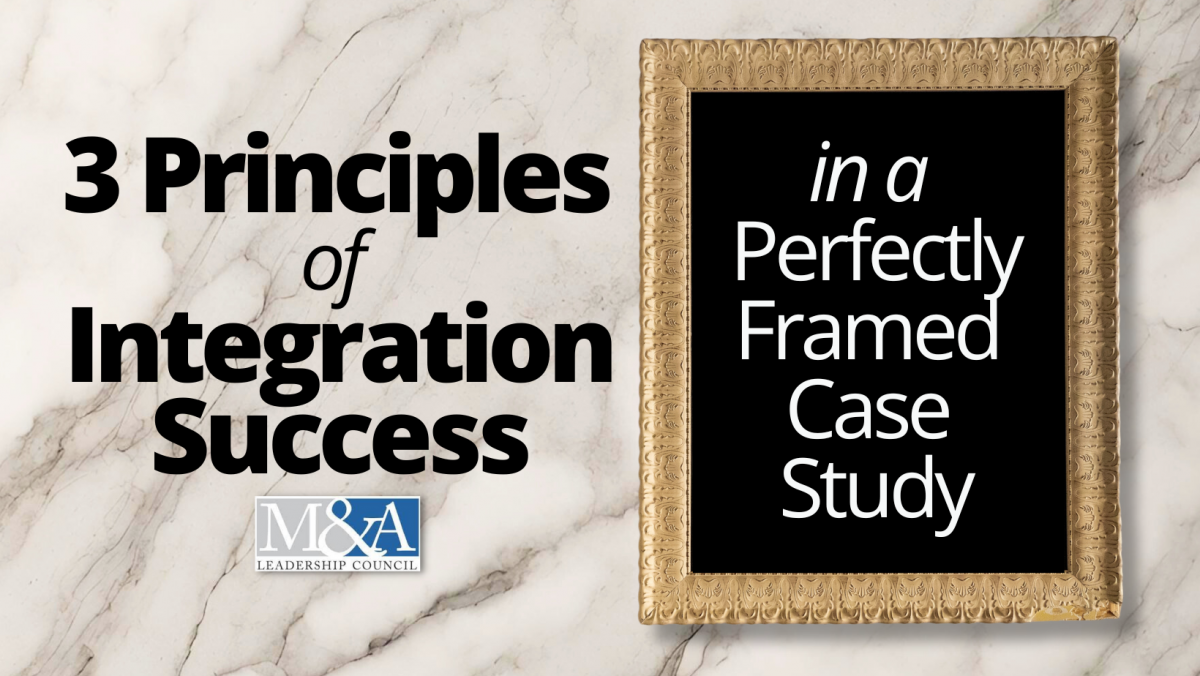Sometimes Complete Integration Isn't the Right Answer
By Jeffrey Cartwright, M&A Leadership Council Alum and Managing Partner of Shoreview Advisors
If you’ve ever dived into M&A strategy, you’ve undoubtedly read about “Newellization,” the acquisition strategy named for a once-tiny household goods company in Freeport, Illinois. There are four key principles of Newellization:
- Consolidate market position – improve service levels and customer relationships
- Rationalize capacity and product lines
- Focus on profit exclusive of growth
- Grow the top and bottom line
Thanks to this approach, Newell grew into an industry giant. The company developed a reputation for buying up brands with great name recognition but lackluster customer service records. This made Holson Burnes an ideal acquisition target for Newell’s subsidiary Intercraft; while the company’s Burnes of Boston brand was the #1 seller of picture frames in department stores, the company was still losing money and missing customer service benchmarks.
After only one day of due diligence, our integration team had to decide whether to Newellize Holson Burnes.
We initially identified no synergies in sales, marketing or product development.
Thus we opted to Newellize Holson Burnes as a hybrid, with certain functions left substantially independent of Intercraft; while the company was fully Newellized, we imposed significant limits on the degree of integration. Operations, Finance and other support functions like IT were fully integrated, while marketing, sales and customer service entities remained separate.
This approach turned out to be incredibly successful, and it aptly demonstrated three key principles of M&A integration success: let the deal rationale guide integration; manage change from top to bottom; and focus on building a high-performance culture.
1. Let the Deal Rationale Guide Integration
The acquisition of Holson Burnes represented a new kind of venture for Intercraft. The highly acquisitive company generally focused on purchasing direct competitors in the mass market, protecting its number-one position in the market. Holson Burnes, however, had the number-one position in the department store market and had recently introduced six products at Wal-Mart. Thus the acquisition rationale for purchasing Holson Burnes was twofold: first, to gain a significant foothold in the more upscale department store market, and second, to protect Intercraft’s primacy in mass market picture frames.
Because we believed the main value of the acquisition was Holson Burnes’s position in a more upscale market, we opted to keep the company mostly separate from Intercraft. We feared that a more thorough integration would ultimately devalue both companies; the influence of Intercraft’s team could push Holston Burnes toward more cost-cutting measures, while the influence of Holston Burnes might lead Intercraft to increase costs. This concern drove all subsequent integration decisions:
- Although we moved the Holson Burnes manufacturing plant closer to Intercraft’s, the plants remained separate. The Holston Burnes operations team managed this transition and continued to oversee manufacturing.
- We maintained a rigorous separation of key departments. To ensure that we avoided that potentially value-eroding “cross-pollination,” sales, marketing and operations personnel remained separate for each entity. Only HR staff went back and forth among locations or entities. Senior executives carried joint business cards, but everyone else retained their original “brand identity.”
- Since personnel was so siloed, it also made sense to maintain two distinct headquarters. The Holston Burnes headquarters remained in Providence, Rhode Island instead of moving to Intercraft’s home base in Austin, Texas.
- The Holson Burnes showroom in New York City remained open since it proved important to maintaining brand identity.
2. Manage Change from Top to Bottom
Prior to acquiring Holson Burnes, Intercraft had acquired Decorel and fully integrated the company. Thus Holson Burnes employees feared that their company would be integrated in the same way, stripping the organization of its culture, leadership and brand identity.
Our integration team appreciated these concerns—and the deal value erosion that often comes when employee productivity falls due to uncertainty after an acquisition. Immediately following Announcement, we launched a comprehensive communication strategy that included both employees and customers:
- All communications emphasized our intention to maintain brand separation, starting with an all-company staff meeting where we communicated our appreciation for their unique brand proposition.
- Joint visits were also made to all department stores to reaffirm our commitment to maintaining the quality of the Holson Burnes brand.
- The integration team held one-on-one meetings with every teammate in executive leadership.
- Members of the Intercraft executive leadership team rotated on site every day for the next three months and ensured visibility at all key meetings.
- Every month, we held hour-long town hall meetings at two locations over all three shifts. We would talk for ten minutes and listen for 50 minutes.
- All meetings were open-door, with representatives of other functions attending. Profit improvement was part of every discussion.
3. Focus on Building a High-Performance Culture
During our very brief due diligence process, we noted multiple opportunities for realigning the Holson Burnes culture to foster high performance. From shifting the culture of decision making to redirecting attention to profitability, these changes resulted in significant deal value. And they paid off for the Holson Burnes team as well: for the first time in many years, the first bonuses were paid, and they were at maximum payout.
- Prior to the acquisition, the Holson Burnes team had relied heavily on outside consultants to make most decisions. We emphasized our belief that it is every employee’s responsibility to personally make decisions that will benefit the company and shareholders, along with our confidence that the Holson Burnes team was uniquely qualified to make these decisions.
- In the previous year, the Burnes of Boston brand had lost $13.7 million on $135 million in revenue, and the company had been focused on growth to the exclusion of profit. We immediately introduced a sharp focus on profit. In addition to making profitability a topic in all meetings, we also unified the bonus program to a single plan where people were rewarded for return on net assets. In the second year, growth in revenue was also added to the bonus program.
- To help the team focus on long-term growth opportunities, we let people know that they were responsible for developing the team they managed. This tactic not only made our leaders feel more confident about their job security, but it also positioned the company to have the human capital it needed for subsequent acquisition.
Post-Integration Results
Using acquisition rationale to guide integration strategy paid off quickly. We saw $12.6 million in profits in the first year. Service levels improved to 98% fill rates at 99% on time. The business also improved due to previous initiatives that were executed, resulting in an improvement from 2.3% operating income to 12.7%. The combined results of both businesses were 17.4% operating income the following year. The major sources of Holson Burnes’s $26 million increase in profits were as follows:
- $7 million from vendor negotiations, volume synergies and competitive bidding
- $4 million from centralizing IT and financial transactions (accounts payables and receivables)
- Combined $4 million from relocating frame manufacturing to a large sister plant and making lean improvements on the album plant
- $3 million from margin mix improvement
- $2 million in other sales, general and administrative (SG&A) expenses
- $2 million that was not specifically assignable but could be attributed to culture shift
---------------------------------------------------------------------------------------------------------------------------------

About the Author
A distinguished alum of the M&A Leadership Council, Jeff Cartwright is a managing partner at Shoreview Advisors. He has led manufacturing, logistics, engineering, sourcing, product development, marketing, and sales for leading multinational consumer products firms for over 35 years. Jeff has held VP of Operations positions in several consumer products companies, including Dorel Juvenile Group, Silver Line Building Products (n.k.a. Andersen Windows), Intercraft Burnes (Division of Newell Rubbermaid), Newell, Frito-Lay, and Procter & Gamble.

